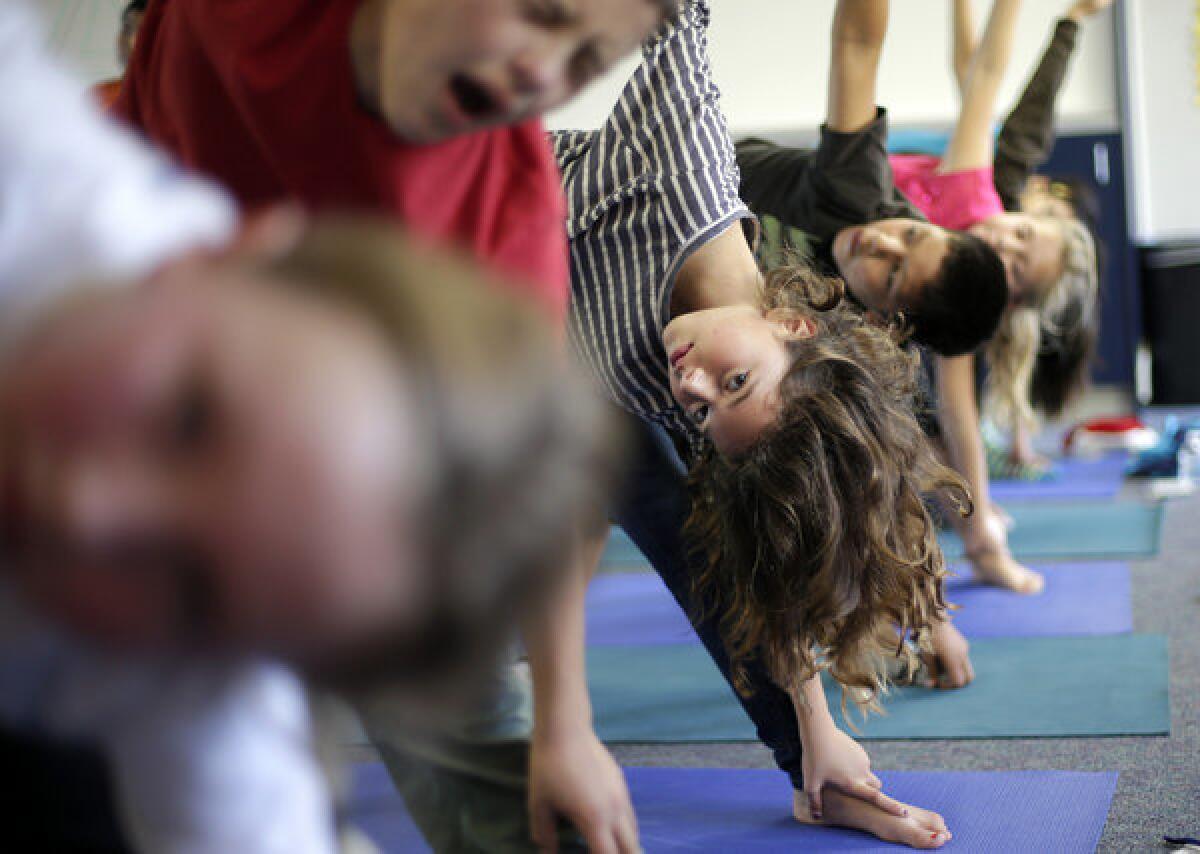Yoga in public schools is exercise, not religion

I have little sympathy for folks like Stephen and Jennifer Sedlock, devout Christians who sued the Encinitas Union School District, claiming that teaching yoga to their kids twice a week amounted to unconstitutional religious indoctrination.
Despite the quasi-spiritual trappings, yoga, as it’s widely practiced by millions of Americans of all faiths, is no instrument of religious indoctrination.
It’s exercise.
In Encinitas, it’s being taught to kids in an effort to reduce bullying, obesity and overcompetitiveness.
Today, a San Diego County Superior Court judge said yoga classes are not the same as religious instruction, and ruled that the classes may continue.
The plaintiffs and their attorney, Dean Broyles of the National Center for Law and Policy, claimed that giving kids a little bit of yoga twice a week amounts to an unlawful embrace of Hinduism, Buddhism, Taoism or Western metaphysics.
I find that ironic, actually. Usually the argument is over whether devout Christians have the right to practice religion any old public place. But I digress.
Last year, as my colleague Tony Perry has reported, Encinitas school officials accepted a half-million dollar grant from the Jois Foundation, named for the late Krishna Pattabhi Jois, an influential yoga teacher who once lived in Encinitas and promulgated the school of yoga known as Ashtanga. The grant provided trained yoga instructors to the schools for what it describes as a “health and wellness program.”
The foundation, supported by hedge-fund billionaire Paul Tudor Jones II and his wife, Sonia, is also funding studies about the effect of yoga on children, which led Broyles to claim in court that the Encinitas school district is using its pupils as “religious beta test subjects.”
But the district had always allowed children whose families objected to be excused from the classes. And that accomodation led to the accusation that the district was depriving the non-yoga practicing children from their state mandated 200 minutes of exercise for every 10 school days. (That was disputed by the district, which said they received their required minutes of exercise in other ways.)
I don’t mean to trivialize the seriousness of the principle at stake: The Sedlocks believed their children were receiving religious instruction. If that had truly been the case, they would have been on the right side of the fight.
But yoga, as it’s often practiced in this country, has long since shed its religion in favor of a watered-down Eastern vibe that sometimes has a cartoonish aspect.
To claim that the yoga being taught in Encinitas schools is a form of religious instruction springs from the same impulse that finds “Harry Potter” books primers on witchcraft, or “Heather Has Two Mommies” a pamphlet promoting lesbianism.
Attorney David Peck, who spoke on behalf of families who support the yoga program, said those who object to the program are looking at it through “a subjective, skewed, fanatical prism.”
I probably shouldn’t admit this, but I got a kick out of reading the trial transcript, particularly the questions posted by San Diego Superior Court Judge John S. Meyer, who seemed surprisingly unfamiliar with yoga, which is as mainstream as Pinkberry yogurt.
“Namaste?” Meyer asked. “And the kids were doing this? And they put their hands together like they were in prayer?”
Oh yes, Broyles said, and not only that, they got extra credit for touching their middle fingers to their thumbs, the familiar hand gesture known as a mudra.
Further, said Broyles, “The final state and ultimate goal of Ashtanga yoga is samadhi. By ‘samadhi,’ they mean absorption into the universal, or union with the divine, your honor. If that’s not an explicitly religious goal, I don’t know what is.”
“What’s the divine?” wondered the judge.
Good question, but as it turned out, beside the point.
Ultimately, the judge made his decision according to the Lemon test, a U.S. Supreme Court ruling that a government body may neither advance nor inhibit religion.
“I suppose when you refer to worship, one is free to worship whatever, whomever one wishes, and that can be virtually anything,” Meyer said during the bench trial. “I suppose some people are accused of worshiping a sports team. There are traditional religions and very untraditional religions, and I’m not sure what religion actually is.”
But, like another judge in another famous case, he knows it when he sees it.
And yoga, as taught in Encinitas schools at least, is not religion, by any definition.
ALSO:
Transit official on BART strike: ‘It could have been much worse’
Mayor talks business with local chambers but skips the big groups
Two women drown after being swept out by high surf near Santa Cruz
Twitter: @robinabcarian
More to Read
Sign up for Essential California
The most important California stories and recommendations in your inbox every morning.
You may occasionally receive promotional content from the Los Angeles Times.











